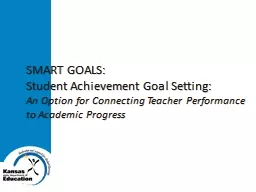

SMART GOALS Student Achievement Goal Setting An Option for Connecting Teacher Performance to Academic Progress What is student achievement goal setting Step 1 Determine needs Step 2 Create specific learning goals based on preassessment ID: 763861
Download Presentation The PPT/PDF document "SMART GOALS: Student Achievement Goal Se..." is the property of its rightful owner. Permission is granted to download and print the materials on this web site for personal, non-commercial use only, and to display it on your personal computer provided you do not modify the materials and that you retain all copyright notices contained in the materials. By downloading content from our website, you accept the terms of this agreement.
SMART GOALS: Student Achievement Goal Setting: An Option for Connecting Teacher Performance to Academic Progress
What is student achievement goal setting? Step 1: Determine needs Step 2: Create specific learning goals based on pre-assessment Step 4: Monitor student progress through on-going formative assessment Step 3: Create and implement teaching and learning strategies Step 5: Determine whether the students achieved the goal
What are the purposes of Student Achievement Goal Setting? Focus on student results Explicitly connect teaching and learningImprove instructional practices and teacher / education specialist performanceTool for school improvement
Step 1: Determining Needs Step 1: Determine needs Step 2: Create specific learning goals based on pre-assessment Step 4: Monitor student progress through on-going formative assessment Step 3: Create and implement teaching and learning strategies Step 5: Determine whether the students achieved the goal Ch. 1, pg. 5
Step 2: Creating SMART Goals Step 1: Determine needs Step 2: Create specific learning goals based on pre-assessment Step 4: Monitor student progress through on-going formative assessment Step 3: Create and implement teaching and learning strategies Step 5: Determine whether the students achieved the goal
What is a student achievement goal? Goal … a statement of an intended outcome of your work: Student LearningDistinct from StrategiesStrategies = Means Goal = End“Are you going to New York or by train?”
Writing a SMART Goal
Sample SMART Goal S pecific: Focused on mathematics achievement. Measurable: Identified MAP assessment as being the measurement tool.Appropriate: As it relates to the work currently being done in this school regarding data analysis and instructional planning.Realistic: The goal of increasing student performance is realistic based on the data for this particular school. 80% of students meeting or exceeding “proficient” may be unrealistic in some schoolsTime-bound: Goal attainment can be addressed by the end of the year. For the 2014-2015 school year all sixth grade students will meet typical growth identified by the MAP assessment. At least 80% of students will meet or exceed “proficient” on the end of the year MAP assessment.
How Smart is this goal? Aspect of Goal Statement Evidence SpecificMeasurableAppropriate RealisticTime-Bound Second Grade Sample During this school year, my students will improve on word knowledge and oral reading fluency.
Step 3: Create and Implement Strategies Step 1: Determine needs Step 2: Create specific learning goals based on pre-assessment Step 4: Monitor student progress through on-going formative assessment Step 3: Create and implement teaching and learning strategies Step 5: Determine whether the students achieved the goal
Step 4: Monitoring Student Progress and Making Adjustments Step 1: Determine needs Step 2: Create specific learning goals based on pre-assessment Step 4: Monitor student progress through on-going formative assessment Step 3: Create and implement teaching and learning strategies Step 5: Determine whether the students achieved the goal
Step 5: Determining Goal Attainment Step 1: Determine needs Step 2: Create specific learning goals based on pre-assessment Step 4: Monitor student progress through on-going formative assessment Step 3: Create and implement teaching and learning strategies Step 5: Determine whether the students achieved the goal
What does research say about goal setting for student achievement? Linked to mastery learning 1 standard deviation higher on average compared with conventional instruction (Bloom, 1984) Includes formative assessments, frequent corrective feedbackLinked to enhancing pre-requisite cognitive skills.7 standard deviation higher on average compared with conventional instruction (Walberg, 1984)Includes initial skills assessment and teaching prerequisite skills that are lackingLinked to assessment for learningFormative assessment in the classroom can result in increases in student learning up to two grade levels (Assessment Reform Group, 2000)Linked to standards-based performance assessmentSchools in Loveland, CO, were among highest percentage increase in student performance after implementing standards-based performance assessment (Stronge & Tucker, 2000) Linked to standards-based instruction18-41 percentage point gains when teachers set and communicate clear goals for learning (Marzano, Pickering, & Pollock, 2001)Linked to data-based decision-makingSchool districts that show multiple (i.e., 3 or more) years of improvement use data to make decisions and encourage teachers to use student learning data to make instructional decision (Cawelti, 2004; Langer & Colton, 2005; Togneri & Anderson, 2003)
Common Challenges Data access & analysis Robustness of data system Teacher & administrator skillsSufficient & appropriate assessmentsWriting SMART goalsClarifying the acceptable amount of progressDeveloping instructionally-based strategies See Marzano et al., Schmoker, Collins, Blankstein, Fullan, etc., etc….
Setting student achievement goals… Focuses on student results Connects teaching with learningImproved instruction in the classroomContributes to school improvement
A Special Thank You… …to the Virginia State Department of Education.